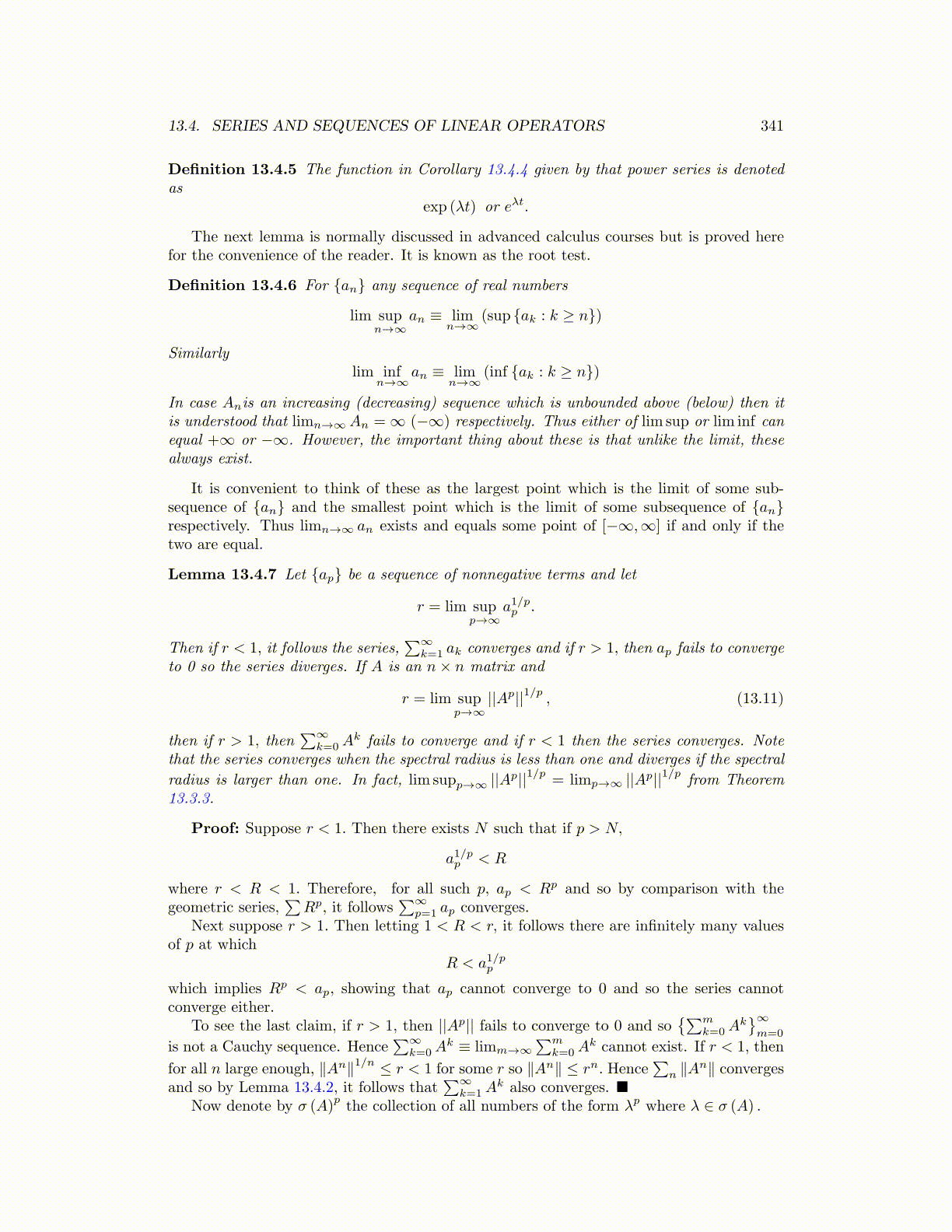
13.4. SERIES AND SEQUENCES OF LINEAR OPERATORS 341
Definition 13.4.5 The function in Corollary 13.4.4 given by that power series is denotedas
exp (λt) or eλt.
The next lemma is normally discussed in advanced calculus courses but is proved herefor the convenience of the reader. It is known as the root test.
Definition 13.4.6 For {an} any sequence of real numbers
lim supn→∞
an ≡ limn→∞
(sup {ak : k ≥ n})
Similarlylim inf
n→∞an ≡ lim
n→∞(inf {ak : k ≥ n})
In case Anis an increasing (decreasing) sequence which is unbounded above (below) then itis understood that limn→∞An = ∞ (−∞) respectively. Thus either of lim sup or lim inf canequal +∞ or −∞. However, the important thing about these is that unlike the limit, thesealways exist.
It is convenient to think of these as the largest point which is the limit of some sub-sequence of {an} and the smallest point which is the limit of some subsequence of {an}respectively. Thus limn→∞ an exists and equals some point of [−∞,∞] if and only if thetwo are equal.
Lemma 13.4.7 Let {ap} be a sequence of nonnegative terms and let
r = lim supp→∞
a1/pp .
Then if r < 1, it follows the series,∑∞
k=1 ak converges and if r > 1, then ap fails to convergeto 0 so the series diverges. If A is an n× n matrix and
r = lim supp→∞
||Ap||1/p , (13.11)
then if r > 1, then∑∞
k=0Ak fails to converge and if r < 1 then the series converges. Note
that the series converges when the spectral radius is less than one and diverges if the spectral
radius is larger than one. In fact, lim supp→∞ ||Ap||1/p = limp→∞ ||Ap||1/p from Theorem13.3.3.
Proof: Suppose r < 1. Then there exists N such that if p > N,
a1/pp < R
where r < R < 1. Therefore, for all such p, ap < Rp and so by comparison with thegeometric series,
∑Rp, it follows
∑∞p=1 ap converges.
Next suppose r > 1. Then letting 1 < R < r, it follows there are infinitely many valuesof p at which
R < a1/pp
which implies Rp < ap, showing that ap cannot converge to 0 and so the series cannotconverge either.
To see the last claim, if r > 1, then ||Ap|| fails to converge to 0 and so{∑m
k=0Ak}∞m=0
is not a Cauchy sequence. Hence∑∞
k=0Ak ≡ limm→∞
∑mk=0A
k cannot exist. If r < 1, then
for all n large enough, ∥An∥1/n ≤ r < 1 for some r so ∥An∥ ≤ rn. Hence∑
n ∥An∥ convergesand so by Lemma 13.4.2, it follows that
∑∞k=1A
k also converges. ■Now denote by σ (A)
pthe collection of all numbers of the form λp where λ ∈ σ (A) .